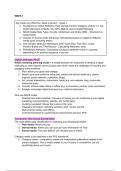WEEK 1
Key Topics (or) What Do I Need to Know? – Week 1
● Touchpoint on Online Platforms: Paid, Owned, Earned, Category; (Article 1.3, see
slides referring to it) Media, Key KPI’s-Metrics used in Digital Marketing
● RACE; Digital Data Types: On-site, Clickstream and Online CRM – Structured vs
Unstructured
● Concept of Journey, Main Attribution methods/techniques w/ regard to different
media types (including slides)
● How (simple) attribution techniques work? (Last-Click, First-Click, Linear,
Position-Based and Time-Decay) – Calculating Attribution value
● Probabilistic Attribution: Calculating touchpoint attribution-value in a journey
depending on its position-sequence in journey.
Digital Landscape: RACE
RACE marketing planning model = a simple structure for companies to develop a digital
marketing or omni channel communication plan which meets the challenges of reaching and
engaging online audience
1. Plan: define your goals and strategy
2. Reach: grow your audience using paid, owned and earned media (e.g. search
engines, social networks, publishers, blogs)
3. Act: prompt interactions, subscribers, leads (e.g. your website, blog, community,
interactive tools)
4. Convert: achieve sales online or offline (e.g. e-commerce, product, price, promotion)
5. Engage: encourage repeat business (e.g. customer advocacy)
Why use RACE model
- Practical and action-oriented; it focuses on tactics you can implement in your digital
marketing communications, website, and mobile apps.
- Customer-centered; follows the customer life cycle
- Integrates all modern marketing activities; paid, owned, earned
- Multi-channel (online and offline)
- Commercial-based on a performance improvement process; KPIs
Touchpoints: Paid-Owned-Earned Media
The most widely used classification in marketing and advertising practice
1. Paid media: Where you pay
2. Owned media: Where you can post your own information for ‘free’
3. Earned media: The most difficult, yet valuable type of media
Category media is an extension to the POE framework.
4. Category media = competitor’s media and independent publications related to the
product category. This is media related to your industry or competitors, but not
specifically about your brand.
, A firm can also earn negative
engagement, earned does
not necessarily mean
positive (e.g. rumors)
It is hard to make managerial decisions for each touchpoint. Paid-Owned-Earned media
helps decision making whether the firm should focus on advertising (paid), content & service
(owned) or engagement (earned)
Digital Data Types
1. Structure
a. Structured data: mostly quantitative; numeric
b. Unstructured data: mostly qualitative; textual or visual data (e.g. images,
text, audio, video, documents)
2. Source of Data
1. On-site data: what you see on website; available and visible to anyone
i. Collected by web scraping
2. Clickstream/Session data: traffic on website-app: what customer do/what
they clink on the website
i. Individual level data (each visitor’s behavior) and aggregate data (total
number of visitors)
ii. Cookies stores your web browser information
iii. Google analytics
3. Online CRM data: customer’ online history with the firm
, First, second, and third party data
1. First-party data is owned by the brand. The data is collected by the brand directly
from their user (e.g. google analytics, surveys, website, email, feedback)
2. Second-party data is first part data that can be purchased or traded with another
brand. It is someone else's first party data that is shared with another company.
Partnership.
3. Third-party data is collected by data collection vendors from separate data sources
and sold brands to use in campaigns and augment existing data. Data collected by
an entity that does not have a direct relationship with the consumer.
4. Zero-party data is data that a customer intentionally and proactively shares with a
company. It is often gathered through interactive means such as surveys, quizzes, or
direct communication.
Metrics/KPIs on digital platform
Marketing metrics: measuring the impact of marketing activities. The most important ones
are referred to as KPIs.
Which metric to use? = Which stage of the funnel am I currently focusing on?
Top of funnel
- SEO/SMM/PCC
- Click-throughs
Middle of funnel
- Bounces
- Readers
- Leads
Bottom of funnel
- Prospects
- Sales
- Loyalty
- Customer advocates
Customer journey
Article 1.1: Santana, S., Thomas, M., & Morwitz, V. G. (2020). The role of numbers in the
customer journey.
Customer Journey has different stages from awareness-consideration (pre-purchase) to
purchase and post-purchase. Each journey stage has certain metrics that are specific to that
phase and more relevant in analytical-objectives.





